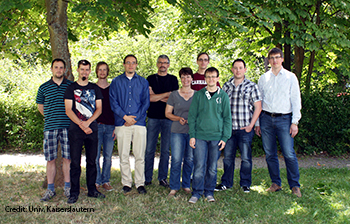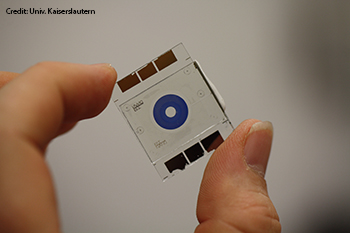
The Physics and Technology of Nanostructures group at the University of Kaiserslautern. Group lead E. Oesterschulze, far right. Lead author T. Deutschmann, fourth from the left.

Electrochromic iris with opaque inner and outer rings
Mechanical iris apertures, a key feature for exposure control in high-quality cameras, have been too bulky to be incorporated into smartphone cameras. Researchers in Germany have now created a micro-iris from an electrochromic polymer that goes from transparent to opaque in response to a small electrical charge. This micro-iris can function in miniaturized environments—like the ever-shrinking smartphone—that traditional mechanical irises cannot (J. Optics, DOI: 10.1088/2040-8978/16/7/075301).
A mechanical iris uses a multi-blade ring structure that can be adjusted in size to control light intensity and tune depth of focus. To create an electrochromic iris with the same function, the University of Kaiserslautern team, led by Egbert Oesterschulze, turned to the polymer Poly(3,4-ethylenedioxythiophene), or PEDOT. The 55-µm-thick device is made from two concentric rings of PEDOT embedded in a transparent electrochemical cell, with the space between electrodes filled with an electrolyte.
The transparent PEDOT rings turn opaque when exposed to an electrical charge. The rings are able to maintain their state for hours without additional current. The PEDOT rings can be switched from transparent to opaque with as current as little as 20 µA and a voltage of 1.5 V, making it ideal for battery-powered devices. And since there are no moving parts, the iris could be tightly packed into a tiny smartphone camera.
Researchers have measured the intensity of the light passing through the electrochromic iris, rate of absorption change and depth-of-focus. They believe the micro-iris has great potential for small integrated camera applications. Lead author Tobias Deutschmann states that the team is working hard to improve PEDOT’s absorption contrast and to shorten the relatively long time it takes to switch from transparent to opaque.
